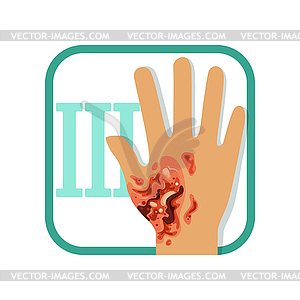

© 2014 American Society for Surgery of the Hand Some common symptoms of second-degree burns include: a wet-looking or seeping wound. Your hand surgeon will coordinate with a therapist if he or she feels that you would benefit from rehabilitation. Deeper ones or those that occur in conjunction with other injuries may require extensive therapy and rehabilitation. Superficial burns generally will not need any formal hand therapy. Long-term follow up with your hand surgeon should be planned to evaluate for potential future surgery that could improve your hand function. Many burned hands will develop contractures, which cause stiff and constricted muscles, months or years after the original injury. Many patients with severe injuries will require more than one operation. Ideally this is within two to three weeks after the injury. Short description: Burn third degree of unsp mult fngr (.
3RD DEGREE BURN FINGER SKIN
After surgery, the hand is splinted (Figure 3) until the skin is healed. Burn of third degree of unspecified multiple fingers (nail), including thumb, initial encounter T23. The dead skin will need to be removed and replaced with skin grafts, which is a surgical procedure. Wound healing occurs within two to three weeks. You can have symptoms of several types of burns in the same place. You may have second-degree burn symptoms with third-degree symptoms in the same area. If there are open and raw surfaces, cleaning, frequent dressing changes, and the application of local topical antibiotics should be performed until the wounds are healed. degree burns if the burn is larger than two to three inches or if the burn is on your face, scalp, genitals, hands, feet, or major joints. A third-degree burn may cause your skin to turn black and dry out. The hand and forearm should be splinted in a position of safety to prevent later stiffness. They usually heal within a week.īlisters on the hand may or may not be trimmed. These are treated primarily for comfort with local pain killers. Those just on the hand may be treated on an outpatient basis if the pain can be adequately controlled. Burns over a major percentage of the body require hospitalization special care. Fourth degree burns are the same as third degree burns but with damage to deeper structures such as tendons, bones and joints.
3RD DEGREE BURN FINGER HOW TO
How to treat a burn depends on the severity of the burn. Third degree burns are full thickness skin damage where the skin is leathery and white in color. Treatment focuses on preventing further problems with stiffness and infection. Initial first aid measures include removing the hand from the source of heat and keeping it clean.


 0 kommentar(er)
0 kommentar(er)
